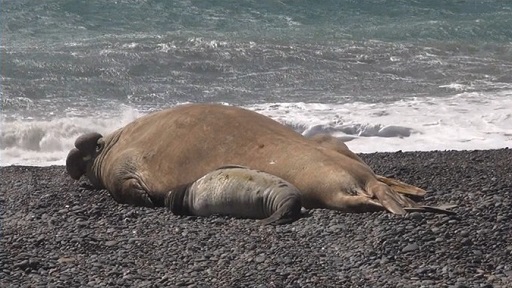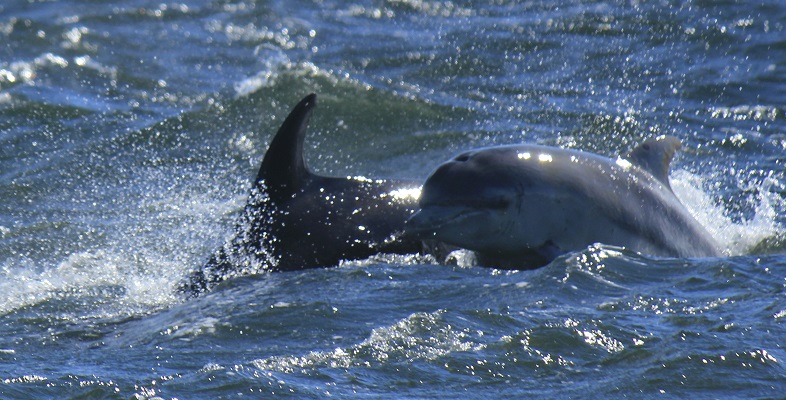3.1 Features of the diving response
The elephant seal (Figure 15(a)) makes repetitive, long-duration dives and some 80–95% of its time at sea is spent submerged. Its dives are of about 20 minutes duration on average, and the intervals at the surface are seldom more than about two minutes. This pattern is repeated almost continuously for between two and eight months. Such abilities are especially useful for those seals that often travel long distances under ice from one breathing hole to another – the Arctic-dwelling ringed seal is one such example and its Antarctic counterpart, the Weddell seal is another. The sperm whale (Figure 15(b)) routinely swims down to depths in excess of 1000 m to hunt giant squid and can stay submerged for over an hour.

Transcript: Video 4 Elephant seals
The length of time a mammal can spend under water depends on the amount of oxygen it takes on board before a dive, as well as its ability to slow the rate at which it uses that oxygen once the dive is under way. It was not until the 1930s and 1940s that biologists began to understand the diving abilities of marine mammals. Work on captive seals making simulated dives in the laboratory – mainly Weddell seals and elephant seals – identified a number of physiological mechanisms that became known as the ‘diving response’, which is detailed below. Subsequent research involving monitoring animals in their natural environment has shown that the full diving response is necessary only in extremis, when the animal is pushed close to its physiological limits.
The main elements of the diving response are as follows:
The animal stops breathing (technically known as ‘apnoea’).
The heart rate slows very markedly – a condition termed ‘bradycardia’. Many seals can reduce their heart rate to about four beats per minute.
The blood pumped by the heart is diverted away from peripheral tissues and muscles to the oxygen-dependent heart, brain and other essential organs. In essence, the animal turns itself into a ‘heart-lung-brain’ machine.
The overall metabolic rate of the diving animal falls as some tolerant tissues – the gut and kidneys, for example – are starved of oxygen. The metabolic rate also falls as the temperature of peripheral tissues – the flippers or flukes, for example – moves closer to that of the surrounding water. (In general, the warmer a tissue, the greater its metabolic rate and subsequent demand for oxygen.) The countercurrent heat exchange ensures that the blood supply to these peripheral tissues is maintained even as tissue temperature falls (Figure 9(b)).
The animal swims in a slow and sustained manner, gliding along to conserve oxygen.
These adaptations allow the animal to make efficient use of the oxygen carried on the dive. Two other adaptations allow the animals to increase the amount of oxygen carried, providing what some biologists have called a ‘physiological scuba tank’:
Oxygen is stored by two proteins in the body: haemoglobin in the red blood cells, and myoglobin in the muscles. Diving mammals have exceptional quantities of both substances.
In some diving mammals, muscles in the spleen contract to squeeze out more oxygen-holding red blood cells when the animal dives. The spleen is also larger, allowing it to hold and release more red blood cells.
Perhaps surprisingly, the main elements of the diving response are not confined to aquatic mammals. A similar response is found in all mammals and most other air-breathing vertebrates, including reptiles and birds. The observation that the diving response seems to be ‘hard wired’ into all mammals has led to some debate about its wider purpose. It may be that it has a role in other situations in which the body has to cope with reduced levels of oxygen.
Question 3
Can you think of any circumstances in which the ability to withstand oxygen starvation might be of use to a terrestrial animal?
Answer
There are a number of possible situations, including vigorous exercise or oxygen starvation during birth.
Of course, we are also mammals and we have our own diving response. Freedivers swim as deep as they can without the aid of scuba tanks. Most human beings can endure apnoea for one to two minutes and dive to a depth of 10–20 m. But it is possible to train to dive for longer periods. The current world freediving record holder, Herbert Nitsch, dived to 253.2 m in 2012. It is possible, with training, for a human to hold their breath for long periods, for example the 22 minutes that Stig Severinsen spent immersed in a tank in 2012. Freedivers can also reduce their heart rates to an amazing six beats per minute, which is not far away from the minimum of a diving seal.

